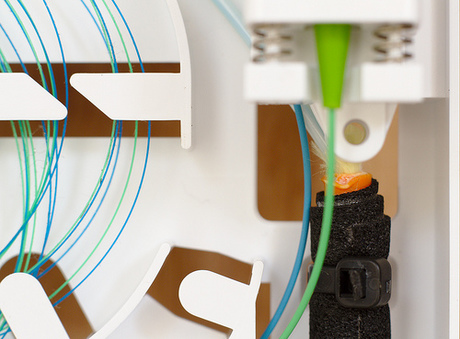Still a chance for a mostly FTTP NBN

If figures from a leaked NBN Co corporate document are any guide, Labor’s version of the NBN may not cost nearly as much as the Coalition has frequently claimed, and the predominantly FTTP vision for the national network may not be quite as dead in the water as predicted.
Fairfax Media last week published a leaked draft version of NBN Co’s 2013-16 Corporate Plan. The 140-page document includes a number of figures, forecasts and targets relating to the speed and cost of deployment of the NBN.
According to the plan, despite the high-profile rollout delays, total forecast capital expenditure for Labor’s version of the NBN project remains on track at $37.4 billion.
Due to the delays, expected cumulative revenue for between FY11 and FY21 has been revised downward by $1.4 billion to $21.6 billion. NBN Co had aimed to make this up with an extra $1.6 billion in private sector debt.
The average cost of connecting premises to the fibre network has fallen from $7400 during the initial rollout to between $2200 and $2500 depending on construction requirements, the plan asserts.
Although critics of the NBN project had often pointed to perceived poor take-up rates, the report states that areas passed by the NBN for more than six months have a take-up rate of over 30%. This compares to a 28% national take-up of broadband in 2006, six years after the introduction of ADSL.
Taken together, the leaked corporate plan casts doubt over the Coalition’s repeated pre-election assertions that Labor’s model of the NBN would cost taxpayers as much as $94 billion to roll out.
New communications minister Malcolm Turnbull has expressed scepticism at the figures included in the report and has asserted that the planned reviews of the NBN project will provide a more accurate picture.
But if the reviews confirm that the FTTP costs are not as high as the Coalition has long insisted, it could theoretically influence the make-up of the final NBN. It appears that replacing FTTP with FTTN for the majority of the national rollout is not as set in stone as had been widely expected.
Turnbull recently insisted that the Coalition is remaining “thoroughly open minded” about the technology to be used in the NBN. The Coalition’s first Statement of Expectations to NBN Co also instructs the company to take a technology-agnostic approach.
This is notable considering that the Coalition’s pre-election NBN policy specifically mentions using FTTN for more than two-thirds of the national rollout - not to mention the repeated lambasting an in-opposition Turnbull gave to Labor for its FTTP choice.
Ovum Consulting Director for Telecom Nigel Pugh said it’s difficult to predict how a finding that an FTTP network can be delivered at the price Labor asserted would influence the rollout of the NBN under a Coalition government. But he said it wouldn’t undermine the Coalition’s case for introducing FTTN and other alternative technologies to the network.
“If you put the numbers to one side, the Coalition’s case was really based around using FTTN to deliver a lower-cost network in a shorter time frame. And that will still be the case if they put FTTN into the mix, which they will do,” he said.
Likewise, if the Coalition does decide to use a greater proportion of FTTN connections, it won’t necessarily be a policy reversal.
“It’s likely that there’ll be a mix of technologies used, including FTTN. Overall, I think the aim of the new business plan will align with the Coalition policy - and that is [to build the NBN] a little bit cheaper and in a shorter time period. So as long as you can meet those two goals then it’s not a reversal in policy.”
According to IBRS Advisor Guy Cranswick, Turnbull has good reasons to be sceptical of the figures presented in the plan. First, he said, new ministers are expected to review operational matters based on a new assessment, not received information.
“Secondly, it was common knowledge that the plans from NBN Co and their costings were very optimistic. I have not done a calculation of those revised costs but there are a few questions about a large fall in connection costs per house but the same level of total budget. It’s not the sort of balance sheet to be accepted without much deeper investigation.”
But telecom analyst Paul Budde said the leaked corporate plan is likely credible. “The document will have to be pretty accurate,” he said. “If they would lie they could be prosecuted for that.”
He said the two most important elements of the leaked plan are the claims the NBN project has stayed within budget and that the rollout delays are only temporary for very acceptable reasons.
“The reviews will confirm that (or not). It looks to me that Turnbull already had some inkling of this as he backed off his earlier comments to stop the rollout. If the plan indeed stays within budget then there would be little reason for him to go through all of the trouble to make changes that could easily unravel the whole project.”
He said Turnbull is likely to make adjustments to the way the rollout is progressing - maybe speeding up deployments to apartments with VDSL or upgrading HFC in some areas.
“[But] Turnbull has always indicated that FTTH is the best end-solution, and if NBN Co can prove it can roll it out within an acceptable budget then there is a very good chance that he will accept that.”
Hybrid environments are here to stay: ensure your technology is ready
These days it seems like it is all about software — so much so that software's integral...
Next-gen wireless network for PCEC
Perth Convention and Exhibition Centre has selected Hewlett Packard Enterprise HPE Aruba...
Intelligent networks: a software-defined future
No matter how sophisticated your technology and people are, they will only reach their full...




